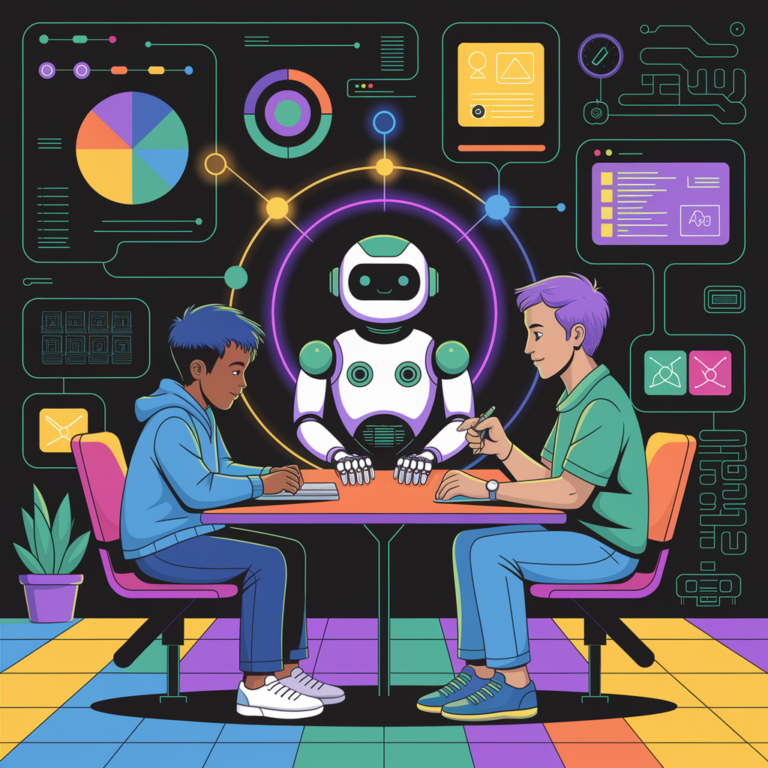From Tomes to Conversations: Using AI to Make Pre-Reading More Engaging
Introductory sections in tomes like the Norton Anthology have served as the foundation for contextualizing literature in the classroom forever. These pre-readings offer historical background, thematic overviews, and authorial insights that provide students with essential frameworks before they begin analyzing primary texts.
And, you know what? They’re the absolute worst way to engage a high school student.
What if we could flip the approach?
Instead of relying solely on traditional introductory readings, we can use AI-driven pre-research projects to make this process more interactive, engaging, and student-led. By frontloading engagement through guided AI conversations, students can enter their pre-readings with a stronger sense of curiosity, connection, and comprehension.
I’m not saying we need to get rid of these readings, I’m suggesting we can prep the students for them in a more engaging way.
The AI Pre-Research Model: Engaging Before the Text
Rather than assigning pre-readings as the first point of contact, students can participate in structured, AI-facilitated discussions that introduce the same major concepts. These 30-40 minute AI conversations allow students to explore historical context, thematic concerns, and key literary movements in a more interactive way before diving into the traditional pre-readings.
Here’s how it works:
- Topic Exploration: Students engage with AI on broad historical and literary themes that will shape their understanding of the primary text. For example, before reading Romantic poetry, students might ask AI to explain the values of Romanticism and how they contrast with Enlightenment ideals.
- Guided Inquiry: Students generate and refine their own questions, directing the conversation toward ideas they find compelling. This builds curiosity and gives them a sense of ownership over their learning.
- Preliminary Analysis: AI can provide excerpts, definitions, and historical references to scaffold student comprehension before they encounter the traditional pre-reading materials.
- Comparison with Textbook Pre-Readings: Once students have engaged in an AI-driven conversation, they can approach traditional introductory materials, like Norton’s context sections, with an active mindset, comparing their AI-motivated insights with scholarly perspectives.
- Class Discussion & Reflection: Students can reflect on what they learned through AI, how it shaped their reading of the anthology’s introduction, and what new questions emerged. They can also identify places where perhaps the AI went off the rails. This gives them the opportunity to see where and why the human component is so important.
Why AI Conversations Work
Personalized Learning Paths
One of the challenges with anthologies is that every student engages with the same information in the same way. AI pre-research allows for more personalized interactions. Some students may ask questions about historical context, while others are drawn to thematic concerns or literary theory.
Active Engagement Over Passive Reading
Instead of passively absorbing pages of background information, students actively shape the conversation by questioning and directing their own research. This pre-research approach aligns with constructivist learning theories, where students build knowledge through inquiry rather than passive reception.
Immediate Feedback and Scaffolding
AI can provide real-time responses, clarification, and additional examples as students explore topics. This scaffolding helps students move from basic comprehension to more analytical engagement before encountering formal scholarly texts.
Increased Retention and Interest
When students are actively engaged in conversation, they are more likely to retain key ideas. Instead of feeling overwhelmed by dense pre-readings, they enter with prior knowledge and an established sense of curiosity.
Implementing AI Pre-Research in the Classroom
- Set Clear Objectives: Ensure that students understand the purpose of the AI conversation—whether it’s to explore a historical period, grasp literary movements, or familiarize themselves with key philosophical debates.
- Structure the Conversation: Provide a few guiding questions to help focus their inquiry. Example: “How does the concept of fate function in Anglo-Saxon literature?”
- Pair with Traditional Readings: Use AI pre-research as a supplement rather than a replacement. Students should still engage with authoritative scholarly pre-readings to see how their AI conversation aligns with academic discourse.
- Encourage Reflection: Have students write a brief reflection on what they learned from AI, what surprised them, and how it shaped their understanding of the traditional pre-reading.
Using Custom GPTs and NotebookLM to Reduce Misinformation
One challenge with AI-generated content is the risk of misinformation or overly generalized responses. Teachers can address this by using tools like custom GPTs or NotebookLM, which allow AI to pull from specific sources, reducing the chance of misleading information.
- Custom GPTs: Educators can create a tailored AI model that references specific texts, ensuring that responses align with classroom materials. This keeps AI-generated discussions focused and relevant.
- NotebookLM: Google’s NotebookLM allows students to interact with AI while grounding responses in a curated selection of texts. This helps limit hallucinations and ensures accuracy by drawing from reliable sources.
By integrating these tools, teachers can feel more confident that students are engaging with accurate, relevant information, setting them up for deeper discussions when they turn to traditional pre-readings.
Rethinking the Role of Pre-Readings
Anthologies remain invaluable resources, but they don’t have to be the first stop on a student’s literary journey. By integrating AI-driven pre-research projects, we can ensure that students arrive at those traditional readings more engaged, better prepared, and more invested in the literature ahead.
Let’s move from passive absorption to active discovery.
Check out a simple (and free) lesson plan on Freytag’s Pyramid that puts these ideas to work.




